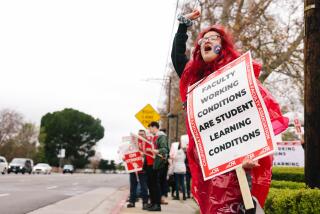Part-Time College Instructors
- Share via
The community colleges have adopted an expedient tactic that harms both students and faculty. That tactic is the excessive use of a second-tier force, part-time instructors, who are equally qualified but lack the economic and professional support enjoyed by their full-time colleagues. State law permits community colleges to hire untenured, part-time instructors who are permitted to teach as much as 60% of a full-time instructor’s course load. Present levels of state funding encourage community colleges to hire so many part-timers that they now make up a majority of community college faculty.
The working conditions of the part-time teacher affect students in a variety of ways.
A part-time instructor earns 60% of what he or she would earn per class as a full-time instructor. Low pay forces most part-timers to hold overly taxing outside jobs or to teach classes at other colleges. Many part-timers teach five, six, seven or more classes. This is more than the teaching load of a full-time community college teacher and sometimes more than double the teaching load of a university professor. Imagine shuttling from work place to work place, imagine the lesser pay and imagine the insecurity of being hired from semester to semester. Clearly, the part-time instructor is the academic equivalent of a migrant laborer.
The students inevitably suffer from the results of their part-time instructor’s low morale and pressure of time. An instructor with too many outside obligations will not reflect as readily on new ways of improving a course, will not do research as readily, and will not be as likely to generate the electricity of real learning.
There are other disadvantages for the student as well. Part-timers rarely have office space or hold office hours, so students miss one-to-one contact.
Finally, a bad example is set for the student when the state and the educational institution imitate the worst side of the private sector by relying on and exploiting a secondary work force.
Does this mean that there is no role for the part-time instructor at the community colleges? Not at all. Part-time instructors can often bring expertise from the workplace in vocational areas, can provide role models as working professionals in the fields of creative arts and sciences, and can fill special curricular needs and round out programs in areas where a full-time instructor is not necessary. They can even be used sparingly by colleges to respond to genuine fluctuations in enrollment.
But if part-timers are to be viewed as special resources, they must be paid appropriately--that is, at the same rate per course as their full-time colleagues--and treated as professional and faculty colleagues, equal in every way to the full-time teaching staff. At the same time they should be hired only for genuine academic reasons--not for the purposes of balancing a stingy community college budget.
GORDON DOSSETT
JAMES PRICKETT
JOE WATTS
ELIZABETH KELLER
CLAIRE O’CONNELL
STANLEY MOCK
LANTZ SIMPSON
DEBORAH KENNEL
ESTHER LANDON
Los Angeles
More to Read
Sign up for Essential California
The most important California stories and recommendations in your inbox every morning.
You may occasionally receive promotional content from the Los Angeles Times.













